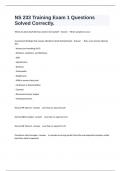NS 233 Training Exam 1 Questions
Solved Correctly.
When do atrial dysrhythmias need to be treated? - Answer When symptoms occur
Assessment findings that require attention (atrial dysrhythmias) - Answer - Pale, cool, clammy (damp)
skin
- Nausea and vomiting (N/V)
- Dizziness, weakness, and faintness,
- SOB
- Hypotension
- Dyspnea
- Tachycardia
- Diaphoresis
- Mild to severe chest pain
- Confusion or disorientation
- Cyanosis
- Decreased urinary output
- Unresponsiveness
Normal PR interval - Answer Less than or equal to 0.20
Normal QRS complex - Answer Less than or equal to 0.12
Normal QT interval - Answer Less than or equal to 0.44
Premature atrial complex - Answer A complex occurring earlier than the next expected complex; earlier
beat than what's expected
,PAC facts - Answer and a compensatory or non compensatory pause
With a PAC, the _____ may have _________? - Answer P waves, different appearances
PAC's occur w/in? - Answer W/in sinus rhythms, considered irregular
PAC's may have a _____ or ______ after it occurs - Answer compensatory, non-compensatory pause
Causes of PAC's - Answer anxiety, caffeine, nicotine, medications, exercise
Because a PAC is ______ a rhythm, merely a ________ of what's happening, it must be written as
________ w/ ______ - Answer not, description, x rhythm, PAC
Treatment of a PAC - Answer based on symptoms, always assess the patient
Supraventricular tachycardia - Answer Sudden onset of tachycardia, any rate greater than 151
Characteristics of SVT - Answer P-waves are present but not usually visible, meaning it can be difficult
to measure a PR interval + QT interval = measure QRS
An SVT rhythm is ______ - Answer regular
What is the difference between SVT + tachycardia - Answer SVT is a rate of 151 or more, while
tachycardia is a rate of 100-150
Bradycardia - Answer rate below 60 bpm
SVT may be seen with what? - Answer Caffeine, nicotine, and some street drugs
Assessment of an SVT patient - Answer HR, and symptoms
, Goal of treating SVT - Answer Slow the HR down and convert to sinus rhythm, then treat symptoms
Treatment of SVT - Answer Valvasa maneuver; bear down,
Medication
Cardioversion
Medications used to treat SVT - Answer Slow HR: Beta blockers, calcium channel blockers,
Convert to sinus rhythm: Adenosine
Atrial fibrillation - Answer Increased irritability of atrial tissue, electrical impulses are generated in
various places in the atria, the atria quiver and are disorganized.
Characteristics of A-fib - Answer - Wavy baseline w/no true p-waves; cannot measure a PT or QT
interval, R-R intervals and rhythm irregular; secondary to random electrical impulses going through AV
node. Only need to measure QRS.
What does A-fib occur with? - Answer MI or Heart disease
In an EKG, what are atria represented by? - Answer P-Waves
Assessment of atrial fib - Answer - What is the HR?
- What symptoms are they displaying?
Goals of A-fib treatment - Answer Prevent thromboembolic complications
Control HR (60-100 bpm) (some can live in a-fib, but not a fast a-fib)
Convert to Sinus
With A-fib, ________ can occur, such as ______ due to _______ traveling to the _______ - Answer
thromboembolic complications, ischemic strokes, blood clots, brain.




